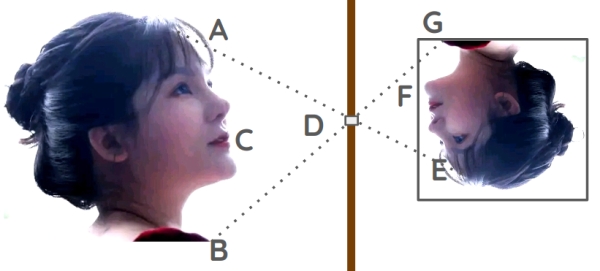The Eye as a Lens
Table of Contents
The humors in the eye:
- are full of animal spirits
- are more transparent
- have more exactly the required shape for this effect.
The shape of the pupil in the eye of a calf is not round. This prevents this painting from being as perfect in that eye.
The images that appear on a white cloth in a dark room are formed in the same way and for the same reason as at the back of the eye.
They are usually much larger and appear in more ways.
If there is no glass in front of the hole that we made in this room, some images will still appear on the cloth if the hole is very narrow. But they will:
- be very confused and imperfect
- become even more so as the hole becomes less narrow
How does vision occur along a straight line?
The size of the pupil makes the colors more vivid.
- It also makes the shapes less distinct, and thus it can only be mediocre.
Objects that are beside the one at the distance at which the eye is positioned, appear much less distinctly if they are much closer or farther away, than if they were almost at the same distance.
These images are inverted. Their figures are changed and abbreviated according to the distance or situation of the objects.
They will be larger, the greater the distance between him and the cloth, so that their size must have, roughly, the same proportion to this distance as the size of the objects that cause them, to the distance between them and the same hole.
If ACB is the object, D is the hole, and EFG is the image, EG is to FD as AB is to CD.

Place a lens in front of this hole. There will be a certain distance where the images appear very distinct on the cloth.
- By moving the cloth closer or farther from the lens, they begin to appear less distinct.
This distance must be measured by the space between the cloth and the lens, rather than between the cloth and the hole.
- If one places the lens a little beyond the hole, the cloth must also be moved a little closer or farther away.
This distance depends in part on:
- the shape of the lens
- the distance of the objects
The less curved the lens is, the farther away the cloth must be.
- This distance affects the size of the images as if there were no lens in front of the hole.
This hole can be much larger when one places a lens in front of it.
- The larger it is, the clearer and more illuminated the images appear
If one covers a part of the lens, they will appear much darker than before.
- But they will not leave the cloth for that.
The larger and clearer the images are, the more perfectly they are seen.
The images would form much more visibly if the eye were very large and deep with a very large pupil.
Two or more slightly flat lentil-shaped lenses, when joined together, will have roughly the same effect as a single curved lens.
- This is because the number of surfaces where refractions occur does not make much difference.
If these lenses are moved away from each other to certain distances, the second can straighten the image that the first has inverted, and the third can invert it again, and so on.